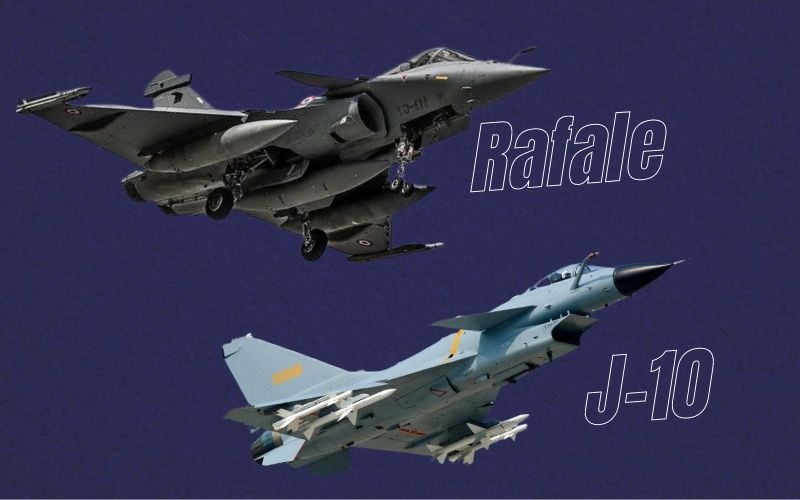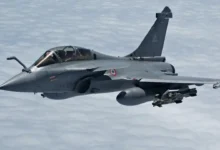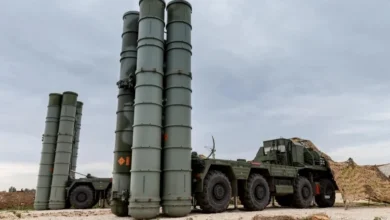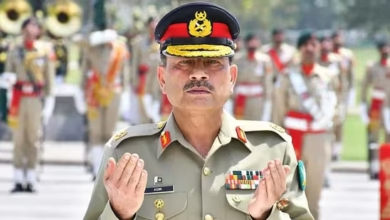Rafale Jet Vs J-10: Do Dassault Fighters Have A Clear Edge Over The J-10?

- Pakistan's Interior Minister, Sheikh Rashid, told reporters in Rawalpindi on December 29 that a squadron of 25 Chinese-made J-10C planes would perform a fly-past on Pakistan Day, March 23. According to the ministry, the Chinese jets are "a response to India's Rafale jets."
- Rafale's AESA radar, along with the Meteor missile, provides it a significant advantage in BVR warfare. Rafale's electronic warfare kit is widely regarded as the best in its class.
Pakistan has formally announced its plan to acquire J-10C aircraft for the Air Force, putting an end to all conjecture. Islamabad intends to purchase the Chinese workhorse in order to compete with the Indian Air Force’s (IAF) inventory of Rafale fighter jets.
The Pakistan Air Force (PAF) has made an order with Chengdu Aerospace Corporation (CAC), one of China’s two major fighter aircraft designers and manufacturers, for FC-20 fighter aircraft. CAC debuted a new export model of their J-10 fighter at the 2019 Dubai Air Show. According to Frontier India, the aircraft, named FC-20E, appears to be a near-identical replica of China’s newest J-10C.
Pakistan’s Interior Minister, Sheikh Rashid, told reporters in Rawalpindi on December 29 that a squadron of 25 Chinese-made J-10C planes would perform a fly-past on Pakistan Day, March 23. According to the ministry, the Chinese jets are “a response to India’s Rafale jets.”
Earlier reports suggested that Pakistan was set to purchase 36 J-10C semi-stealth 4.5 generation aircraft from China, but neither side has confirmed this. However, the ultimate number has been established at 25. These aircraft join Pakistan’s existing fleet of JF-17 fighter jets, which were jointly developed by Beijing and Islamabad as part of a large-scale programme.
Previously, the aircraft was seen during joint air operations between China and Pakistan. The J-10C variant was apparently photographed at the Pakistan Air Force Chief’s office weeks before the purchase was publicly announced.
According to some accounts, Pakistan has been displeased with the existing JF-17s because of engine inefficiencies that China has yet to address despite repeated requests from the Pakistan Air Force.
With the delivery of the French-made Rafale fighters to India nearing completion, Islamabad may have recognised the necessity to strengthen the Pakistan Air Force’s fighter aircraft fleet in order to achieve a balance of force.
Pakistan’s fifth-generation fighter jet programme, Project Azm, is in jeopardy, and its current fleet of JF-17s does not appear capable of competing with Indian Rafales, the J-10C becomes an apparent choice. The J-10C variant was apparently photographed at the Pakistan Air Force Chief’s office weeks before the purchase was publicly announced.
According to some accounts, Pakistan has been displeased with the existing JF-17s because of engine inefficiencies that China has yet to address despite repeated requests from the Pakistan Air Force.
With the delivery of the French-made Rafale fighters to India nearing completion, Islamabad may have recognised the necessity to strengthen the Pakistan Air Force’s fighter aircraft fleet in order to achieve a balance of force.
Pakistan’s fifth-generation fighter jet programme, Project Azm, is in jeopardy, and its current fleet of JF-17s does not appear capable of competing with Indian Rafales, the J-10C becomes an apparent choice.
The Rafale, on the other hand, is a twin-engine fighter that can operate from a land base or an aircraft carrier. All combat aviation operations, including air superiority and air defence, close air support, in-depth strikes, reconnaissance, anti-ship strikes, and nuclear deterrence, can be carried out by the totally flexible Rafale.
Rafale’s AESA radar, along with the Meteor missile, provides it a significant advantage in BVR warfare. Rafale’s electronic warfare kit is widely regarded as the best in its class.
The J-10C is powered by a Chinese-developed engine, which replaces the Russian AL-31 engine that was used in prior models. For long-range interception, it uses the PL-15, a dual-stage BVRAAM with a range of 200 kilometres or more. The PL-15 is also employed by the JF-17 Thunder, therefore experts say the J-10C doesn’t bring anything new to the table.
The Rafale, on the other hand, employs the Meteor, which is widely regarded as the world’s best air-to-air missile. It employs a next-generation technology known as the ducted ramjet, which assures a 200-kilometer range, but more importantly, unlike the PL-15, it maintains the same kinetic energy throughout its flying range.
One significant distinction between the two planes is that, unlike the Rafale, which has been employed in combat missions in Afghanistan, Libya, Mali, Iraq, and Syria, the J-10C has never been in a genuine combat situation. As a result, the Rafale is a battle-tested and battle-hardened fighter aircraft.
Despite the Pakistan Air Force’s possession of jointly produced JF-17 fighters, they are no match for the Indian fleet’s Rafale. The F-16, which is now in the Pakistani fleet, has capabilities that are similar to those of the Rafale, although it is old and powered by a single engine.
Is the Rafale a Better Aircraft?
“The Pakistan Air Force is likely to have ordered FC-20E fighter aircraft from Chengdu Aerospace Corporation (CAC), which is comparable to and manufactured by the same company as the Chinese J-10C. The fighter is said to have improved stealth, AFAR (Active Phased Antenna Array), and a wider arsenal of weaponry. The Pakistan Air Force, which currently operates JF-17 aircraft, will benefit from the upgrading.”
“Although the difference between J-10C and FC-20E is uncertain, J-10C is predicted to outperform FC-20E. The fighter was referred to as JS-10 by the Pakistani Minister. Like FC-1, which is known as Joint Fighter -17 or JF-17, FC-20E may have been dubbed Joint Strike Fighter -10.
“In both WVR and BVR, the FC-20E or JS10 are not comparable to Rafales. According to Chacko, “the FC-20E allows more freedom against India because the US bans F-16 use against India.”
“Many believe the J-10C is a duplicate of Israel’s Lavi, which was designed and dropped. It’s a good plane that used the Su-30’s engine until the Chinese came up with their own.
Engines from China and Russia are still inferior to those from the West. AESA radars with LPI are used on both the Rafale and the J-10C. I believe Rafale has a superior electronic warfare system, although they are both Delta Canard designs.”
“Rafale fires the Meteor, and J-10C fires the PL-15 active radar homing missiles,” military aviation expert Amit Mukherjee said when asked if the J-10C or an aircraft of similar specifications could challenge the Rafale. The PL-15, according to the Chinese, has a longer range than the Meteor. The missile is directed by the data link from the parent aircraft until it goes pitbull. Rafale has a strong data connection. I have no idea how well the Chinese data link is performing.”
“The PAF’s use of single-engine J-10Cs will not change the military balance in South Asia.” J-10s have been reported being delivered to Pakistan since the 2000s, but unless hundreds are delivered, they will have a limited influence on the PAF’s capabilities.”
The J-10C, on the other hand, is a highly spectacular model, and its inclusion in the PAF will delay the branch’s inventory’s obsolescence. However, starting in 2025, the PAF should have access to 4.5 and 5th generation fighters (the Turkish TF-X comes to mind), as well as semi-stealthy or stealth UCAVs, allowing it to truly bridge the technology/firepower gap with the IAF.
The IAF’s timeframe appears to be too onerous for any foe at the moment. The Indian Defence Research and Development Organisation (DRDO) is working on a ‘heavy’ stealth fighter called the AMCA, as well as another carrier-based fighter.
Meanwhile, the IAF appears to have a bright future with France’s aerospace industry, not only because of the Rafale, but also because of the numerous opportunities for technology transfers and collaborative ventures later this decade.
And this is most likely why the US and Russia continue to want to sell new fighters to the IAF. In a matter of years, next-generation UAVs and UCAVs will change the IAF’s doctrine and reach.
“However, with Imran Khan in charge, it’s crucial to observe how Beijing-Islamabad ties have expanded to a surprising degree.” This has a military dimension as well, with Pakistan acquiring new Chinese frigates, submarines, tanks, and air defences, with the cumulative effect being rather substantial when compared to Pakistan’s own military-industrial initiatives.
Observing Pakistan’s less well-known but highly advanced projects like the Babur land-attack cruise missile, which is cost-effective and available to the army and navy, is more important to me than comparing the quality of either air force,” Miguel Miranda says.
According to expert view, the J-10C will be a force multiplier for the Pakistan Air Force. On paper, Rafale appears to have the upper hand, but no one can predict what will happen when they square off.







Facebook Comments